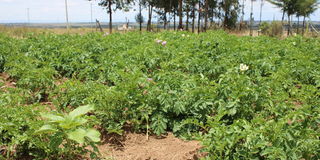‘We keep planting and losing’: Women farmers left out of climate relief funds

Participants during Lutheran World Federation forum presenting findings from its 2024 analysis of gender-responsive climate action across 20 countries at Waridi Paradise Hotel in Nairobi on June 12, 2025.
What you need to know:
- Despite policy gains, women farmers like Emily remain uninformed of climate compensation funds meant to ease disaster losses.
- Kenya’s gender-climate policies show promise, but weak implementation keeps vulnerable women like Emily in the dark.
Emily Kinyanjui, a smallholder farmer in Nyandarua, has heard whispers about “loss and damage” funds meant to compensate farmers affected by climate disasters. But no one has told her how to access them, despite frequently losing her onions, potatoes, and maize to floods or prolonged drought.
“At the market, you hear the young men talk about how the government will give them money for their losses, whether from too much rain or too little,” she said last week.
“But when you ask who is registering people for this money, they say maybe the county director of agriculture, but they are not sure. So, I don’t know.”
Women like Emily may soon find themselves better informed and included in climate financing decisions. The State Department of Gender Affairs and Affirmative Action has established a sub-committee on gender, climate change, and disaster risk reduction under the National Gender Sector Working Group.
Gender Cabinet Secretary Hanna Cheptumo, on June 5, during the second bi-annual National Gender Sector Working Group meeting in Nairobi, said the sub-committee would be instrumental in coordinating climate matters through a gender lens and in supporting the implementation of responsive interventions.
The move comes as a new global assessment by the Lutheran World Federation placed Kenya seventh among 20 countries in implementing the Gender Action Plan (Gap), adopted at Cop23 under the UN Framework Convention on Climate Change. The Gap Performance Index ranges from 0 to 3, rating countries as follows: 0–1.5 (poor), 1.5–2 (medium), 2–2.5 (good), and above 2.5 (very good).

A potato farm in Nyandarua County on April 2, 2025.
The assessment measured five priority areas of action defined in Gap. Kenya scored 2 in gender capacity, owing to its frequent submissions to the UN convention on gender and a medium-high level of media coverage on gender and climate change. However, capacity building by ministries and institutions remains comparatively low.
On gender balance and leadership, Kenya scored 2.25, attributed to strong women representation in Cop delegations, including a notable presence at Cop28 and a functional National Gender and Climate Change Focal Point.
In terms of policy coherence, Kenya scored 2, as its National Climate Change and Health Strategy includes a gender focus, and 49 per cent of climate financing projects have gender components. On the implementation of gender-responsive climate policy, the country also scored 2, with its Nationally Determined Contributions and National Adaptation Plan containing gender-responsive elements.
Kenya is also a member of the Gender-Responsive Just Transition and Climate Action Partnership. However, the score for monitoring and reporting was lower at 1, as gender issues are addressed in national reports but not systematically.
Presenting the findings virtually on June 12, 2025, Thomas Hirsch, co-consultant and founding director of Climate and Development Advice, noted that although Kenya’s policy frameworks appear promising, implementation often remains the weakest link, reducing their actual impact on communities such as Emily’s.
“Having gender in the plans is one thing,” he said. “But without strong implementation and monitoring mechanisms, the benefits fail to reach the intended beneficiaries.”
Emily hopes the new sub-committee will lead to tangible change. “If there is money to help us, then someone should come and tell us what to do,” she said. “We can’t keep planting and losing everything.”

